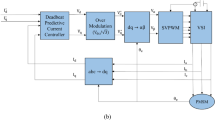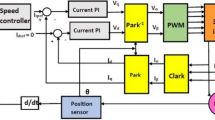Abstract
This paper presents brain emotional controller (BEC)-based adaptive mechanism in Model Reference Adaptive System (MRAS) to control sensorless permanent magnet synchronous motor (PMSM) drive. BEC is a bio-inspired intelligent controller developed using neurobiological connections of mammalian brain by inspiring limbic system. The developed controller is applied as speed controller and parameter estimation (i.e. rotor speed and rotor position) of PMSM drive. The proposed BEC stability is proved to guarantee convergence characteristics. The performance of BEC-based adaptive mechanism is evaluated in simulation environment, and obtained results are compared in real time in hardware-in-loop (HIL) environment. In order to hold the effective performance of the proposed method compared with fuzzy logic controller with similar tests, further integral performances are evaluated for BEC and fuzzy logic controllers. Results demonstrated in HIL and in simulation show applicability, robust and sensitiveness of the proposed BEC method.














Similar content being viewed by others
Abbreviations
- \(V_{d} ,V_{q}\) :
-
Stator voltages
- \(I_{d}^{*} ,I_{q}^{*}\) :
-
Reference currents
- \(\omega_{{\text{r}}}\) :
-
Rotor speed
- \(\hat{\omega }_{{\text{r}}}\) :
-
Estimated rotor speed
- δ :
-
Rotor position
- \(\hat{I}_{d}^{*} ,\hat{I}_{q}^{*}\) :
-
Adjustable currents
- \(R_{d} ,R_{q}\) :
-
Stator resistance per phase
- \(L_{d} ,L_{q}\) :
-
d-axis and q-axis inductance
- P :
-
No. of pole pairs of motor
- \(\varphi_{{\text{f}}}\) :
-
Rotor magnetic flux linking the stator
- T L :
-
Load torque
- T e :
-
Electromagnetic torque
- B m :
-
Friction coefficient of motor
- J m :
-
Moment of inertia of the motor and load
- AG:
-
Amygdala
- O :
-
Orbitofrontal cortex
- S i :
-
Sensory input
- SC:
-
Sensory cortex
- EC:
-
Emotional cue
- u p :
-
Plant output
- u c :
-
Controller output
- S ia :
-
Adaptive sensory input
- SCa :
-
Adaptive sensory cortex
- ECa :
-
Adaptive emotional cue
- u ac :
-
Adaptive controller output
References
Holden, A.V.: Nonlinear science: the impact of biology. J. Frankl. Inst. 334B(5/6), 971–1014 (1997)
Farina, M.; Deb, K.; Amato, P.: Dynamic multi objective optimization problems: test cases, approximations, and applications. IEEE Trans. Evol. Comput. 8, 425–442 (2004)
Baud, R.; Fasola, J.; Vouga, T.; Ijspeert, A.; Bouri, M.: Bio-inspired standing balance controller for a full-mobilization exoskeleton. IEEE Int. Conf. Rehabil. Robot. 2019, 849–854 (2019). https://doi.org/10.1109/ICORR.2019.8779440
Papez, J.W.: Proposed mechanism of emotion. Arch. Neurol. Psychiatry 38, 725–743 (1937)
Arbib, M.A.: From cybernetics to brain theory, and more: a memoir. Cogn. Syst. Res. 50, 83–145 (2018)
Lautin, A.: The Limbic Brain. Kluwer Academic Publishers, New York (2002)
Moren, C.B.: A computational model of emotional learning in the amygdala. Cybern. Syst. 32(6), 611–636 (2000)
Moren, J.: Emotion and Learning: A Computational Model of the Amygdala. Ph.D. dissertation, Lund University, Lund (2002)
Lucas, C.; Shahmirzadi, D.; Sheikholeslami, N.: Introducing BELBIC: brain emotional learning based intelligent controller. Int. J. Intell. Autom. Soft Comput. 10(1), 11–22 (2004)
Sadeghieh, A.; Sazgar, H.; Goodarzi, K.; Lucas, C.: Identification and real-time position control of a servo-hydraulic rotary actuator by means of a neurobiologically motivated algorithm. ISA Trans. 51, 208–219 (2012)
Jafari, M.; Xu, H.; Carrillo, L.R.G.: A neurobiologically-inspired intelligent trajectory tracking control for unmanned aircraft systems with uncertain system dynamics and disturbance. Trans. Inst. Meas. Contol 41(2), 417–432 (2019)
Jafari, M.; Fehr, R.; Carrillo, L.R.G.; Quesada, E.S.E.; Xu, H.: Implementation of Brain Inspired Emotional learning based intelligent controller for flocking of multi-agent systems. IFAC Pap. Online 50(1), 6934–6939 (2017)
Lotfi, E.; Rezaee, A.A.: Generalized BELBIC. Neural Comput. Appl. 31, 4367–4383 (2019). https://doi.org/10.1007/s00521-018-3352-1
Roshanaei, M.; Vahedi, E.; Lucas, C.: Adaptive antenna applications by brain emotional learning based on intelligent controller. IET Microw. Antennas Propog. 4(12), 2247–2255 (2010)
Qutubuddin, M.D.; Yadaiah, N.: Modeling and implementation of brain emotional controller for permanent magnet synchronous motor drive. Eng. Appl. Artif. Intell. 60, 193–203 (2017)
Alahakoon, S.; Fernando, T.; Trinh, H.; Sreeram, V.: Unknown input sliding mode functional observers with application to sensorless control of permanent magnet synchronous machines. J. Frankl. Inst. 350, 107–128 (2013)
Ayala, H.V.H.; Coelho, L.S.: Cascaded evolutionary algorithm for nonlinear system identification based on correlation functions and radial basis functions neural networks. Mech. Syst. Signal Process. 68–69, 378–393 (2016)
Kim, W.; Chen, X.; Lee, Y.; Chung, C.C.; Tomizuka, M.: Discrete-time nonlinear damping back stepping control with observers for rejection of low and high frequency disturbances. Mech. Syst. Signal Process. 104, 436–448 (2018)
Ohara, M.; Noguchi, T.: Rotor position sensorless control and its parameter sensitivity of permanent magnet motor based on model reference adaptive system. IEEE Trans. Ind. Appl. 132(3), 426–436 (2012)
Esteban, E.; Salgado, O.; Iturrospe, A.; Isasa, I.: Model-based approach for elevator performance estimation. Mech. Syst. Signal Process. 68–69, 125–137 (2016)
Popov, V.M.: Hyperstability of Control Systems. Springer, Berlin (1970)
De la Sen, M.: On the asymptotic hyperstability of dynamic systems with point delays. IEEE Trans. Circuits Syst. I Fundam. Theory Appl. 50(11), 1486–1488 (2003)
Benlaloui, I.; Drid, S.; Chrifi-Alaoui, L.; Ouriagli, M.: Implementation of a new MRAS speed sensorless vector control of induction machine. IEEE Trans. Energy Convers. 30(2), 588–595 (2015)
Mahesh, P.; Yadaiah, N.: Real time implementation of state estimation technique for a sensorless PMSM drive. In: IEEE 39th National Systems Conference (NSC), pp. 1–6 (2015)
Kou, P.; Zhou, J.; Wang, C.; Xiao, H.; Zhang, H.; Li, C.: Parameters identification of nonlinear state space model of synchronous generator. Eng. Appl. Artif. Intell. 24(7), 1227–1237 (2011)
Wu, Y.; Li, G.: Adaptive disturbance compensation finite control set optimal control for PMSM systems based on sliding mode extended state observer. Mech. Syst. Signal Process. 98, 402–414 (2018)
Chaoui, H.; Sicard, P.: Adaptive fuzzy logic control of permanent magnet synchronous machines with nonlinear friction. IEEE Trans. Ind. Electron. 59(2), 1123–1133 (2012)
Niu, H.; Yu, J.; Yu, H.; Lin, C.; Zhao, L.: Adaptive fuzzy output feedback and command filtering error compensation control for permanent magnet synchronous motors in electric vehicle drive systems. J. Frankl. Inst. 354, 6610–6629 (2017)
Opal-RT, OP 5600, HIL Box, information guide. www.opal-rt.com
Qutubuddin, M.D.; Yadaiah, N.: A new intelligent adaptive mechanism to for sensorless control for permanent magnet synchronous motor drive. Brain Inspired Cogn. Archit. 24, 47–48 (2017)
Guyton, A.C.: A Text Book of Medical Physiology. Elsevier, Amsterdam (2006)
He, J.; Maltenfort, M.G.; Wang, Q.; Hamm, T.M.: Learning from biological systems: modeling neural control. IEEE Control Syst. Mag. 21(4), 55–69 (2001). https://doi.org/10.1109/37.939944
Mendonca, D.J.; Al Wallace, W.: A cognitive model of improvisation in emergency management. IEEE Trans. Syst. Man Cybern. Part A Syst. Hum. 37(4), 547–561 (2007)
Gadanho, S.C.; Hallam, J.: Emotion-triggered learning in autonomous robot control. Cybern. Syst. 32, 531–559 (2001)
Pillay, P.; Krishnan, R.: Modeling, simulation and analysis of permanent-magnet motor drives, part i: the permanent-magnet synchronous motor drive. IEEE Trans. Ind. Appl. 25(2), 265–273 (1989)
Tripathi, S.M.; Dutta, C.: Enhanced efficiency in vector control of a surface-mounted PMSM drive. J. Frankl. Inst. 355, 2392–2423 (2018)
Dorf, R.C.; Bishop, R.H.: Modern Control Systems, 7th edn. Addison Wesley Longman, Menlo Park (1995)
Tavazoei, M.S.: Notes on integral performance indices in fractional-order control systems. J. Process Control 20, 285–291 (2010)
Author information
Authors and Affiliations
Corresponding author
Rights and permissions
About this article
Cite this article
Qutubuddin, M., Yadaiah, N. Performance Evaluation of Neurobiologically Inspired Brain Emotional Adaptive Mechanism for Permanent Magnet Synchronous Motor Drive. Arab J Sci Eng 47, 3181–3199 (2022). https://doi.org/10.1007/s13369-021-06111-7
Received:
Accepted:
Published:
Issue Date:
DOI: https://doi.org/10.1007/s13369-021-06111-7




